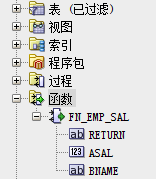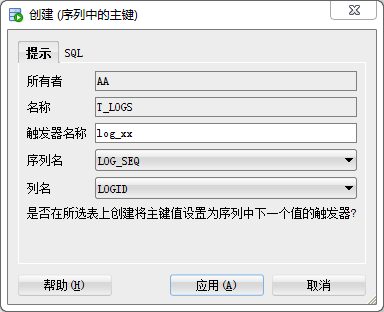一、自定义函数
格式:
create or replace function 函数名(参数名 参数类型...)
return 返回值类型
as
xx vachar2(20) --申明变量
begin --开始
--编写逻辑位置
return xxxx
end 函数名; --结束
例1:将名为WARD员工的工资和所有的员工的工资进行比较。
1 --自定义函数 2 create or replace function fn_emp_sal(asal in number,bname in varchar2) 3 return varchar2 --返回值 4 as 5 --申明变量 6 vreturn varchar2(20); 7 vsal emp.sal%type; --vsal的数据类型与sal的数据类型一样 8 begin 9 --写逻辑的位置 10 --将查询出的sal赋值给vsal 11 select sal into vsal from emp where ename=bname; 12 if asal>vsal then 13 vreturn:='工资比'||bname||'高'||(asal-vsal); 14 elsif asal<vsal then 15 vreturn:='工资比'||bname||'低'||(vsal-asal); 16 else 17 vreturn:='工资一样'; 18 end if; 19 return vreturn; 20 end fn_emp_sal; --结束 函数名,注意要加;
之后编译成功则显示:

进行查询:
1 select ename,sal,fn_emp_sal(sal,'WARD')from emp;
执行结果:

二、匿名语句块
格式:
declare
--声明变量
xx varchar2(20);
begin--开始
---编写逻辑位置
end;--结束
例1:工资小于3000的员工提薪3000。
1 --匿名语句块 2 declare 3 --声明变量 4 vsal number; 5 vename varchar2(20); 6 begin 7 vename:='SMITH'; --静态写入 8 --若想从控制台动态输入数据,则改成 vename:=&ename; 9 --输入:'SMITH' 10 select sal into vsal from emp where ename=vename; 11 if vsal<3000 then 12 update emp set sal=3000 where ename=vename; 13 end if; 14 end;
执行结果:

800->3000:

如将更新的数据添加文本中,可以再新建一个日志表和序列,增加一个触发器去记录更新的数据。
(1)增加一个日志表为t_logs:

(2)增加一个序列为log_seq:

(3)为表t_logs增加一个触发器log_xx,创建(序列中的主键):

(4)在上一段代码的第12行添加:
1 insert into t_logs(txt) values(vename||'工资增加了'||(3000-vsal));
(5)执行结果:

例2:对收入低于1600 发奖金300 1600-2500发奖金200 2500-5000发奖金100。
1 declare 2 vename varchar2(20); 3 vsal_comm emp.sal%type; 4 vcomm emp.comm%type; 5 vmsg varchar2(20); 6 vrow emp%rowtype;---行变量 相当于Java的Object 7 begin 8 vename:='SMITH'; 9 select * into vrow from emp where ename=vename; 10 11 --奖金 12 if vrow.comm is null then 13 vcomm:=0; 14 else 15 vcomm:=vrow.comm; 16 end if; 17 18 --收入 19 vsal_comm:=vrow.sal+vcomm; 20 21 if vsal_comm<1600 then 22 vmsg:='发奖金300'; 23 elsif vsal_comm>1600 and vsal_comm<2500 then 24 vmsg:='发奖金200'; 25 elsif vsal_comm>2500 and vsal_comm<5000 then 26 vmsg:='发奖金100'; 27 else 28 vmsg:='不发'; 29 end if; 30 DBMS_OUTPUT.PUT_LINE(vename||'过节费'||vmsg); --控制台输出 31 end;
点击查看->DBMS输出->点击+,连接该数据库,则会显示:

三、循环
1、loop 循环
例:循环输出1-10,相当于do...while
1 declare 2 i number(2):=1; 3 begin 4 loop 5 exit when i>10; ---循环结束条件 6 DBMS_OUTPUT.PUT_LINE(i); --控制台输出 7 i:=i+1; 8 end loop; 9 end;
2、 while loop 循环
例:循环输出1-7,相当于while。
1 declare 2 i number(2):=1; 3 begin 4 while i<7 loop 5 DBMS_OUTPUT.PUT_LINE(i); 6 i:=i+1; 7 end loop; 8 end;
应用:例如插入1000条数据。
---恢复内容结束---
一、自定义函数
格式:
create or replace function 函数名(参数名 参数类型...)
return 返回值类型
as
xx vachar2(20) --申明变量
begin --开始
--编写逻辑位置
return xxxx
end 函数名; --结束
例1:将名为WARD员工的工资和所有的员工的工资进行比较。
1 --自定义函数 2 create or replace function fn_emp_sal(asal in number,bname in varchar2) 3 return varchar2 --返回值 4 as 5 --申明变量 6 vreturn varchar2(20); 7 vsal emp.sal%type; --vsal的数据类型与sal的数据类型一样 8 begin 9 --写逻辑的位置 10 --将查询出的sal赋值给vsal 11 select sal into vsal from emp where ename=bname; 12 if asal>vsal then 13 vreturn:='工资比'||bname||'高'||(asal-vsal); 14 elsif asal<vsal then 15 vreturn:='工资比'||bname||'低'||(vsal-asal); 16 else 17 vreturn:='工资一样'; 18 end if; 19 return vreturn; 20 end fn_emp_sal; --结束 函数名,注意要加;
之后编译成功则显示:

进行查询:
1 select ename,sal,fn_emp_sal(sal,'WARD')from emp;
执行结果:

二、匿名语句块
格式:
declare
--声明变量
xx varchar2(20);
begin--开始
---编写逻辑位置
end;--结束
例1:工资小于3000的员工提薪3000。
1 --匿名语句块 2 declare 3 --声明变量 4 vsal number; 5 vename varchar2(20); 6 begin 7 vename:='SMITH'; --静态写入 8 --若想从控制台动态输入数据,则改成 vename:=&ename; 9 --输入:'SMITH' 10 select sal into vsal from emp where ename=vename; 11 if vsal<3000 then 12 update emp set sal=3000 where ename=vename; 13 end if; 14 end;
执行结果:

800->3000:

如将更新的数据添加文本中,可以再新建一个日志表和序列,增加一个触发器去记录更新的数据。
(1)增加一个日志表为t_logs:

(2)增加一个序列为log_seq:

(3)为表t_logs增加一个触发器log_xx,创建(序列中的主键):

(4)在上一段代码的第12行添加:
1 insert into t_logs(txt) values(vename||'工资增加了'||(3000-vsal));
(5)执行结果:

例2:对收入低于1600 发奖金300 1600-2500发奖金200 2500-5000发奖金100。
1 declare 2 vename varchar2(20); 3 vsal_comm emp.sal%type; 4 vcomm emp.comm%type; 5 vmsg varchar2(20); 6 vrow emp%rowtype;---行变量 相当于Java的Object 7 begin 8 vename:='SMITH'; 9 select * into vrow from emp where ename=vename; 10 11 --奖金 12 if vrow.comm is null then 13 vcomm:=0; 14 else 15 vcomm:=vrow.comm; 16 end if; 17 18 --收入 19 vsal_comm:=vrow.sal+vcomm; 20 21 if vsal_comm<1600 then 22 vmsg:='发奖金300'; 23 elsif vsal_comm>1600 and vsal_comm<2500 then 24 vmsg:='发奖金200'; 25 elsif vsal_comm>2500 and vsal_comm<5000 then 26 vmsg:='发奖金100'; 27 else 28 vmsg:='不发'; 29 end if; 30 DBMS_OUTPUT.PUT_LINE(vename||'过节费'||vmsg); --控制台输出 31 end;
点击查看->DBMS输出->点击+,连接该数据库,则会显示:

三、循环
1、loop 循环
例:循环输出1-10,相当于do...while
1 declare 2 i number(2):=1; 3 begin 4 loop 5 exit when i>10; ---循环结束条件 6 DBMS_OUTPUT.PUT_LINE(i); --控制台输出 7 i:=i+1; 8 end loop; 9 end;
2、 while loop 循环
例:循环输出1-7,相当于while。
1 declare 2 i number(2):=1; 3 begin 4 while i<7 loop 5 DBMS_OUTPUT.PUT_LINE(i); 6 i:=i+1; 7 end loop; 8 end;
应用:例如插入1000条数据。
1 declare 2 i number(4):=1; 3 begin 4 while i<1000 loop 5 insert into emp(enmae) values('老王'||i); 6 i:=i+1; 7 end loop; 8 end;
3、for in 循环
已知循环次数的循环控制语句。
1 declare 2 begin 3 for i in 40..50 loop 4 DMBS_OUTPUT.PUT_LINE(i); 5 --for in 语句自动给i+1,故这里是个空操作,加不加null都可。 6 end loop; 7 end;